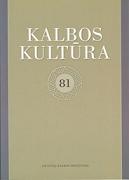Sociolingvistinis šnekamajai kalbai būdingos leksikos tyrimas
Sociolinguistic investigation into the lexis characteristic of spoken language
Author(s): Giedrius TamaševičiusSubject(s): Language and Literature Studies
Published by: Lietuvių Kalbos Institutas
Keywords: Dictionary; lexis; non-standard language; dialectal words; jargon,
Summary/Abstract: A shortage of data of spoken language in the Dictionary of Contemporary Lithuanian (Dabartinės lietuvių kalbos žodynas) currently poses a serious problem for translators and compilers of bilingual dictionaries where Lithuanian is the main language of explanation; it equally poses a problem for language learners. The paper introduces an investigation into the lexis characteristic of spoken language aimed at identifying words which are most frequent in contemporary spoken and proving or disproving the hypothesis that non-standard language tends to penetrate into public use. Results of the above investigation could be used in selecting spoken language data for the inclusion into currently compiled dictionaries. The above investigation was based on the method of questionnaires. In addition to the main question about the use of the lexis of spoken Lithuanian, there were two other questions included. They focused on the impact of age and gender, two social variables, on the responses. The questionnaires also included words of standard Lithuanian marked as spoken and included into the Dictionary of Contemporary Lithuanian (Dabartinės lietuvių kalbos žodynas) as well as dialectal and jargon words known and widely used by the majority of the language community. The results of the above pilot investigation have shown that the majority of the researched words are used in private discourse by over half of the respondents. The same words in public are mainly used by men in the youngest age group. An absolute majority of the respondents (almost 98 per cent) failed to identify a single word which is not used in the meaning characteristic of spoken language. Similar research should prompt lexicographers that they should consider the amount of spoken lexis to be included in the future Dictionary of Standard Lithuanian (Bendrinės lietuvių kalbos žodynas) and how to fill in the gap of actual use in Lithuanian lexicography.
Journal: Bendrinė kalba (iki 2014 metų – Kalbos kultūra)
- Issue Year: 2008
- Issue No: 81
- Page Range: 206-217
- Page Count: 12
- Language: Lithuanian

